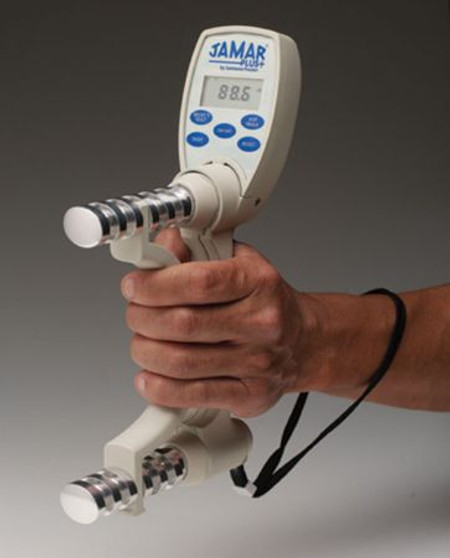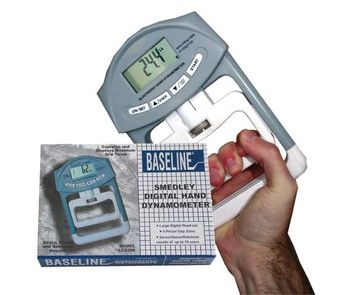Ideal for routine screening of grip strength and initial and ongoing evaluation of clients with hand trauma, dysfunction, or post-op recovery. The Jamar Plus hand dynamometer was used to develop the original normative handgrip strength data, combining digital load sensor technology with high-quality hydraulics for accurate and reliable measurements over years of service.
Further, the Jamar Plus Hand Dynamometer measures maximal isometric handgrip strength as an important component of a clinical evaluation as an indicator of overall strength and general health, and as a predictor of accelerated decline and dependency in functional activities of daily living (ADL) in aging.
It's Unique Design
- Has an easy-to-read LCD display
- Has a push-button console that includes a button to zero last reading stored
- Readout displays isometric grip force in pounds and kilograms from 2 - 200 lbs. (90 Kg)
- Body constructed from aluminum with a scratch resistant UV coating.
The Jamar Plus Digital Hand Dynamometer also Features
- Digital Load Cell Technology.
- Rapid Exchange Testing with audible signals and automatically calculates the Average.
- Standard Deviation and Coefficient of Variation.
- With a low battery light indicator and a two-minute automatic shut off feature it helps conserve the battery power.
- Uses two AAA batteries.
- Comes in a reusable storage container.
Professions and Settings that use Handgrip Dynamometers
- Physical Therapists, Occupational Therapists, and Hand Therapists: To determine baseline strength measurements in the monitoring of progress overtime in patients receiving rehabilitation treatment for hand and elbow injury and dysfunction.
- Medical Clinics and Research: A quick and easy to administer protocol to assess muscle function across populations and in performing associated research.
- Geriatric Populations: Handgrip strength data can provide important information related to muscle wasting progression and frailty in older persons, relevant to the design of therapeutic interventions and use in monitoring of conditions.
- Workforce: As a screening tool to assess the capability and injury risk for specific job tasks involving frequent and strenuous handgrip work. It has also been used as a tool to determine compensation from work related injuries.
- Educational: The measurement of handgrip strength can be used to teach key kinesiological principles through demonstration toward strength in body part positioning and proper ergonomics.
References
- Wind A.E., et al. Is grip strength a predictor for total muscle strength in healthy children, adolescents, and young adults? Eur. J. Pediatr. 2010; 169:281-287.
- Taekema, D., et al. Handgrip strength as a predictor of functional, psychological and social health. A prospective population-based study among the oldest old. Age and Aging, Volume 39, Issue 3, May 2010, Pages 331-337
Click HERE to view a chart of Handgrip Strength Norms











